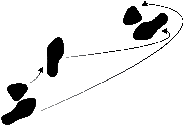|
|
Foxtrot & Ballroom
Social Foxtrot, Slowfox, Quickstep, Modern vals, Wienervals, Chachacha, Rumba, Samba, Pasa doble, Jive
You can dance Ballroom both as a social dance or a competition dance. Ballroom dances are the most populare dances in the
west and are useful in balls, parties, weddings and at the dance floors of Uppsalas student nations. In these occasions
usually more simplified versions are used.
In Studio-K we learn both the competition and the social versions of the Ballroom dances.
The Ballroom dances are devided in to Standard and Latin dances:
Latin dances:
Cha cha cha uppkom som en jazzig variant av folkdansen Danzon på Cuba på 1950-talet. I Sverige och många andra länder dansas
Cha cha cha som social dans. Den är också den populäraste av latin ballrom danserna.
Samba
Rumba
Jive är den europeiska utvecklingen av Lindyhopen och dansas till mer fartfylld rock eller swing musik.
Paso doble
Standard dances:
Social Foxtrote is the most common ballroom dance and you can dance it to anything that is played on the radio or in the night clubs.
It is considered part of the general knowledge to at least know the basics and some simpler figures in Foxtrote and we recommend that
you start with a foxtrote class if you have never danced Ballroom before.
Slowfox & Quickstep are the competitive versions of the Foxtrote and are danced to very slow and very fast music.
Slowfox is caractarised by its elegent and floating figures while the Quickstep is danced with Charlston inspired, joyfull steps.
If you are a good dancer you can ofcourse dance both the Slowfox and the Quickstep also in social occasions.
A Quickstep could look like this.
Modern Walz is the slower but more figurative version of the walzes. Walz is actually an old dance usually favored by
pesents but nowadys it is more associated with Ballrooms and romantic weddings. It is easy to learn Modern Walz and very useful for
the coming balls and weddings. Se the video here.
Viennese Walz was created when some composers from Vienna and other cultural centers of Europe started to make
art music inspired by populare walz melodies. These new walzes were actually too quick to be suitable for dancing but
still they got populare among the fancier social circles which looked down on the "common walz".
The steps in the Viennese walz and the figures were simplified to make it easier to dance in a fast beat.
The result was a semi-choreografed dance with only 8 figures which never the less requires good physical condition and quite a lot
dancing experience to look really nice.
Modern tango was created in the 1920s by crossing the Argentinian tango with the Europian Ballroom traditions. The Modern tango
is carachtarised by its passionate appearance and sudden change of directions for the body and the head accompanied
to a steady staccado beat.
Välkommen!
|
|
 |
|





